Versatility is one of the key reasons for the popularity of Barcelona as a holiday destination. There are countless museums for art lovers, a rich history dating back to Roman times, beaches right next to the city center, numerous beautiful parks, and world-famous festivals & sports events.
The neighborhoods of Barcelona differ greatly between each other, each having its own distinctive characters. There’s a favorite pastime to be found for everyone. Some love the buzz of the lively, narrow streets of the Gothic Quarter, while some prefer the spacious avenues of Eixample. Contrarily, many are looking to get away from the city center and relax at the beachfront.
Barcelona is a fantastic destination to combine a city break with a relaxing beach holiday – the choice is yours. All these factors make the city of Gaudí a top candidate for your next holiday destination!
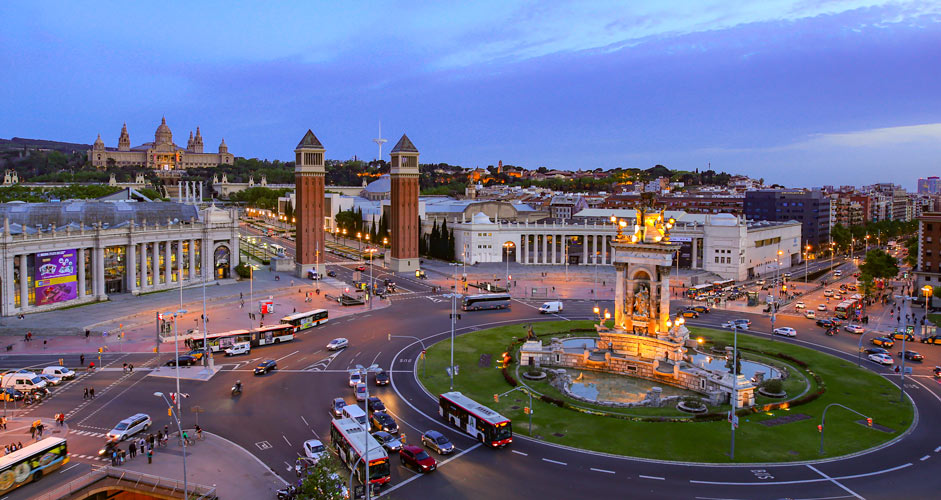
Where to stay
Staying in the right area is a very important holiday decision. Often, you may feel frustrated for having chosen an area far from the key places of interest. Barcelona is a big city, and there are many factors to take into consideration when choosing the right spot for accommodation.
There’s a good chance you’ll find the best compromise between prices and location a bit farther away from the very center. From our where to stay section, you'll find the pros and cons of each neighborhood in central Barcelona.
Find your accommodation in Barcelona from Booking.com Hotel Map
Slideshow of Barcelona
Attractions and things to do in Barcelona
You won’t run out of things to do in this city, even if you’re planning to stay a bit longer. The parks of central Barcelona are perfect for lovely picnics; especially The Parc de la Ciutadella is like a green mirage in the middle of the city, where both the locals and tourists gather to spend time.
The capital of Catalonia is famous for its attractions. The fabulous buildings such as Sagrada Familia or La Pedrera designed by Gaudí are true masterpieces as such must-see-sights at least from outside. Certain museums are open free of charge on Sundays and museum days, if you want to save money conveniently.
Barcelona has plenty in store for families with children. In addition to its beaches, there’s a zoo, an aquarium, a science center and much more for kids to enjoy.
Should you look for something more ordinary, certain cinemas show films in their original language. And don’t forget about the great experience the open-air movie theaters offer during the summertime.
Find your own favorite activities in the city of Gaudí and check our wider selection of tips at Things to do in Barcelona.
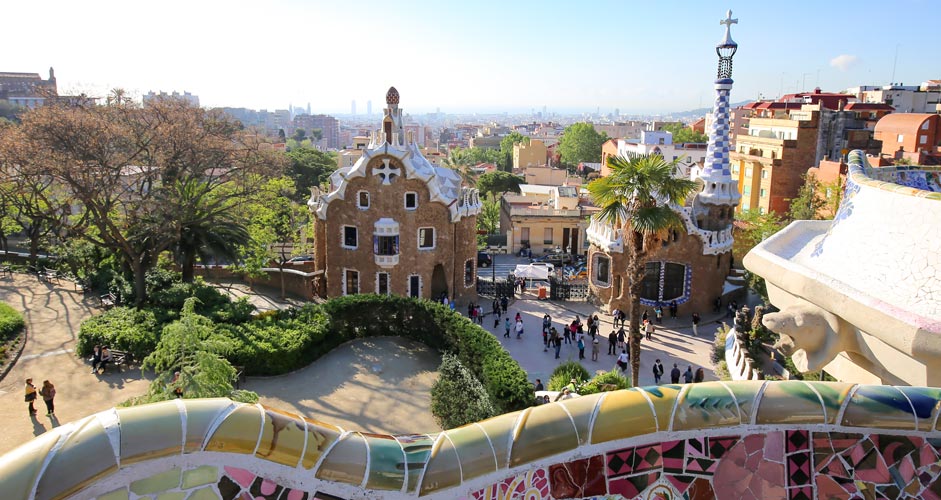
Barcelona beaches
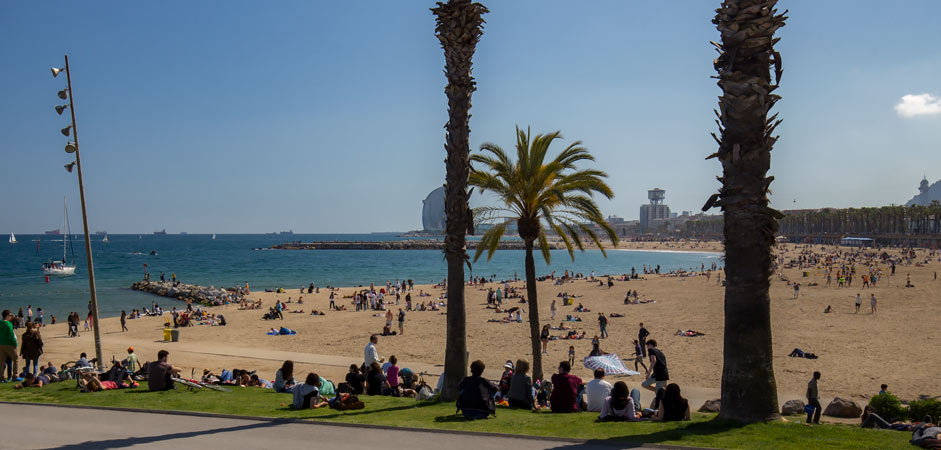
The vast sand stretch offers plenty of beaches for you to discover your favorite spot. There's a versatile selection of beaches ranging from busier beaches to more quiet ones. Find out more information about Barcelona beaches.
Shopping in Barcelona
According to Eurostats, prices of clothing in Spain are clearly below the European average. Therefore, you’ll save money, if you do your shopping in Barcelona. There are seasonal sales twice a year. Summer sales start around July 1 and last until about August 31, depending on the shop. Winter sales start on December 7 and last until March 6. There’s a big selection of brands available - from small local designers to famous international designers.
Passeig de Gràcia
The most famous and glamorous shopping street of Barcelona is called Passeig de Gràcia. The 1,3-kilometer-long street is full of designer shops on both side of the vast avenue. World-famous designers such as Gucci, Stella McCartney and Prada have their shops along Passeig de Gracia.
There are some shops offering more affordable clothing such as Mango, Zara and Macson, but if you’re not looking for the luxury brands, you might as well go elsewhere with a bigger selection of affordable clothing.
How to get: Metro lines L2, L3 and L4, stop at Passeig de Gracia
El Corte Inglés, Plaça de Catalunya
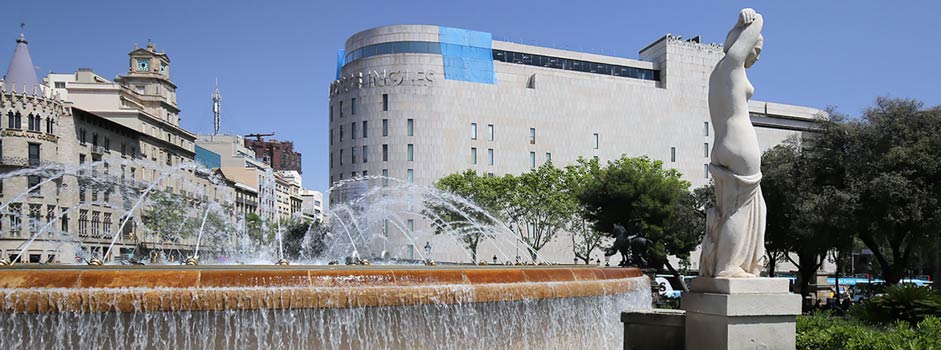
The biggest department store chain in Spain, El Corte Inglés, has stores in many locations in Barcelona. They offer mainly upscale brands. Clothing-wise, they have departments for men, women, youth, and there’s another department for shoes. The first and the biggest El Corte Inglés in Barcelona is located on the eastern side of Plaça de Catalunya.
If you’re looking for after sports items, their selection is very narrow. Instead, El Corte Inglés at Portal de l’Àngel has a much bigger selection for sports.
Tip: There are very nice views towards Plaça de Catalunya from the top floor cafe of the department store.
- Website: elcorteingles.es
- How to get: Metro lines L1 and L3, stop at Plaça de Catalunya. The metro line L4, stop at Urquinaona.
Avinguda de Portal de l’Àngel
Another great shopping street, situated near El Corte Inglés of Plaça de Catalunya, is called Portal de l’Àngel. The shops there offer cheaper brands compared to Passeig de Gracia. The brands include, for example, Massimo Dutti, Bershka, Mango, Foot Lockers, Zara and H&M. El Corte Inglés has another store there, consisting mainly of sports clothing.
- How to get: Metro lines L1 and L3, stop at Plaça de Catalunya. Metro line L4, stop at Urquinaona.
Carrer de Pelai
The Pelai street starts from the top of the Rambla. It connects Plaça de Catalunya and Plaça de Universitat. The street is famous for its many shoe shops. The street is only 400 meters long, and you’ll often find discounts even outside the top sales seasons.
- How to get: Metro lines L1 and L3, stop at Plaça de Catalunya. Metro line L2, stop at Universitat.
L’illa Diagonal
L’illa Diagonal is a shopping center with over 170 shops. It’s located on the longest street of Barcelona, Avinguda Diagonal, on the border of L’Eixample and Les Corts. While most of the shops focus on clothing, there’s plenty of other products on offer as well, ranging from home ware to electronics. Major commercial clothing brands like Primark, Desigual and the big French sports shop Decathlon have shops here.
- Website: lilla.com
- How to get: Metro line L3, stop at Maria Cristina. It takes around 11 minutes to walk to the shopping center from the station.
Las Arenas
The former bullring at Plaça de Espanya was modified into a shopping center and an exhibition venue in 2011. You’ll find brands such as Desigual, Benetton and Mango in Las Arenas. The selection isn't big, so if you wish to have a long shopping day, it's better to go to one of the bigger shopping centers.
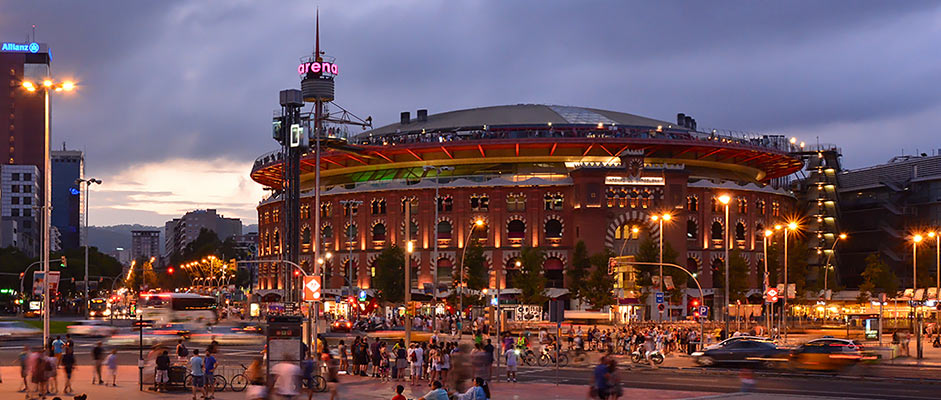
Tip: There’s a rooftop platform going 360 degrees around the Las Arenas, with very nice views over Barcelona. For a fee, there’s a lift outside the shopping center that takes you to the rooftop. Inside the shopping center, you can take an escalator up to the rooftop for free.
- Website: arenasdebarcelona.com
- How to get: Metro lines L3 and L1, stop at Espanya.
Diagonal Mar
The shopping center Diagonal Mar is situated at the end of Diagonal street, in Poblenou neighborhood. The shopping center has around 200 shops & restaurants, thus being the second largest shopping center of Barcelona. You’ll find shops from various categories: electronics, clothing, home ware, accessories etc. The biggest shops include the clothing store Primark and the electronics store Mediamarkt.
- Website: diagonalmarcentre.es
- How to get: Metro line L4, stop at El Maresme I Fòrum.
La Maquinista
The biggest shopping center of Barcelona, La Maquinista, is located far away from the city center, near Sant Andreu. Over 200 shops in 90 000 square meters makes it the biggest shopping center in Barcelona. The selection of shops isn’t significantly better compared to what is on offer closer to the center, which is why it's worth thinking twice before going all the way there. La Maquinista in only covered by roof, providing spacious, airy feel to the building complex. This nice detail makes you feel like you’re not in a shopping center.
- Website: lamaquinista.com
- How to get: Metro line L1, Torras i Bages. Lines L9N and L10, stop at Bon Pastor.
La Roca Village
The boutique outlet village La Roca is located some 40-minutes’ drive away from Barcelona city center. There are over 100 stores of big internationally renowned brands, mainly on clothing and jewelry & accessories. The area resembles a typical Catalan village, which makes a nice setting for shopping.
Nevertheless, good bargains are hard to find. Although they advertise discounts up to 60%, the actual discounts are often quite modest. Assuming you spend 20 euros for transportation and another 20-30 euros for average quality, yet pricy, food and drinks, you need to buy a lot of merchandise to make the trip worth your while.
- Website: larocavillage.com
- How to get: Shuttle bus Shopping Express leaves from Passeig de Gracia 6. (between Carrer Casp and Gran Via de les Corts Catalanes)
Events and holidays in Barcelona 2024-2025
With regards to events, summers are the busiest time of the year in Barcelona. In addition to international music festivals, city districts organize their own festivals in summer. At their best, district festivals are spectacular events, where decorating streets is a matter of honor. Gracia and Sants have the biggest district festivals of the city.
St. George’s Day – The rose and book festival (23rd of April)
Saint George’s Day, named after the patron saint of the city St. Jordi, is also known as The Day of the Rose or The Day of the Book. 23rd of April each year, the city is filled with booths decorated with Catalan flags, where men buy roses for special women in their lives and women buy books in return.
The idea was raised by a Valencian bookseller to commemorate the death of Miguel Cervantes, the national writer of Spain, by a rose and a book. Internationally, the day is known as World Book Day.
However, St. George’s Day is not a national holiday in Barcelona.
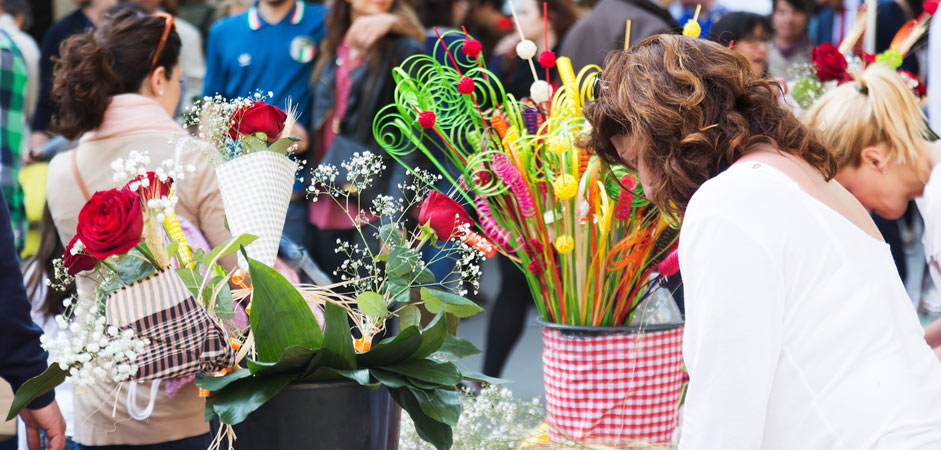
F1 Spanish Grand Prix 2025 (May 29 – June 1)
In the second weekend of May, F1 fans fill the city to witness the F1 Spanish Grand Prix at the Montmeló race track. F1 fans wearing the colors of their favorite racing teams are a common sight in the streets, but the event doesn’t cause any chaos in the city.
However, you should be aware of the weekend, as the hotel prices tend to go up in the whole city during the Grand Prix.
Primavera Sound 2025 (June 5– 7)
Primavera Sound in the beginning of June attracts indie music enthusiasts to the city. This three-day event is one of the biggest festivals of the year in Barcelona.
Sonar 2025 (June 12 - 14)
Traditionally, Sonar continues the festival infested June after Primavera. The main focus of Sonar is in electronic music, and it’s been in the city’s festival program since 1994.
Sant Joan (June 23)
Sant Joan in Catalan, or san Juan in Spanish, is a mid-summer festival to celebrate the longest day of the year as well as the birth of John the Baptist.
In Barcelona, celebrations take place on beaches, where especially the youth gathers to have picnic until the dawn. One of the traditions of Sant Joan is to pop firecrackers and to eat stuffed buns, Coca de Sant Joan.
Cruilla 2025 (July 9 – 12)
Cruilla is yet another huge music event with both the biggest pop & rock bands as well as smaller genres equally represented. The event is held in the Port Forum area in Poblenou.
Festa Major de Gràcia (August 15 - 21)
For the locals, the Gràcia district festival is one of the most anticipated events of the year. Streets are covered with decorations and art pieces, which really are a matter of honor for the locals. Preparations are commenced way before the actual event. Crafting the art pieces is also a competition, and the winner is awarded at the end of the festival.
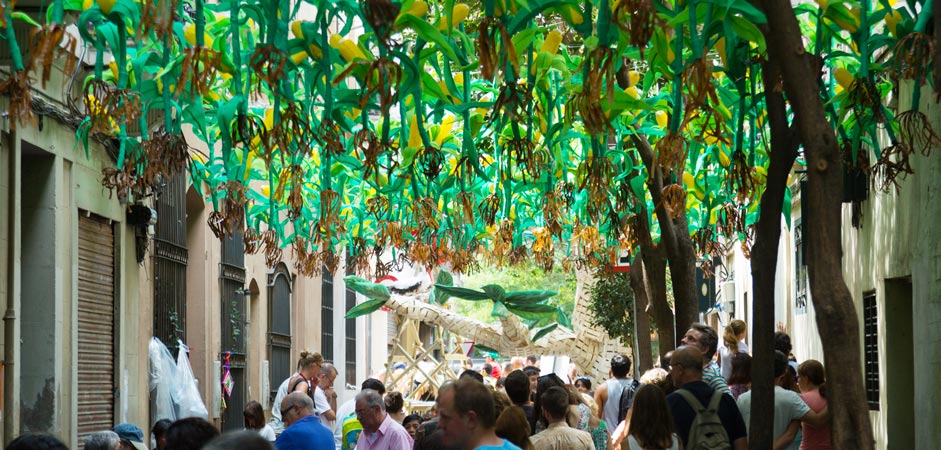
During the festival, there are music and art performances in various locations around Gràcia, and in the evenings the atmosphere resembles that of a large open-air music festival. Food and drink booths are an important part of the festival – there’s everything from mojitos to grill food to choose from.
Since the narrow streets of Gràcia are swarming with people and music’s playing loud, you should avoid picking a hotel room from the area during the festival.
Festa Major de Sants (August 24 – September 1)
The district festival of Sants is equivalent to that of Gracia. Sants covers a larger area than Gràcia, and therefore the Sants festival is not as congested as the Gràcia festival.
La Diada – National day of Catalonia (September 11)
La Diada, the National Day of Catalonia, is celebrated on September 11 each year. The day originates from the year 1714, when Catalonia was defeated after 14 months of siege by France. As a consequence, Catalonia became a part of France, which at the time was ruled by the Bourbon dynasty.
The national day is a holiday in Catalonia. Traditionally, nationalist Catalonians gather demonstrate for Catalonian independence, which the Spanish central government is not willing to grant to Catalonia.
The demonstrations are mostly peaceful, but the streets are congested in the center.
La Mercè (September 20 – 24)
La Mercè ends the summer festival season. The purpose of this religious festival is to celebrate one of the patron saints of Barcelona, Mare de Déu de la Mercè. Organized by the city of Barcelona, the festival shows loud and clear in the streets of Barcelona for almost two weeks. The actual holiday takes place on 24 September.
During the course of the couple of weeks, there are various types events and concerts. The most characteristic of the celebrations are the giant paper puppets, Gegants, Catalonian local dance, Sardana, human towers, Castellers, and the Correfoc fire run.
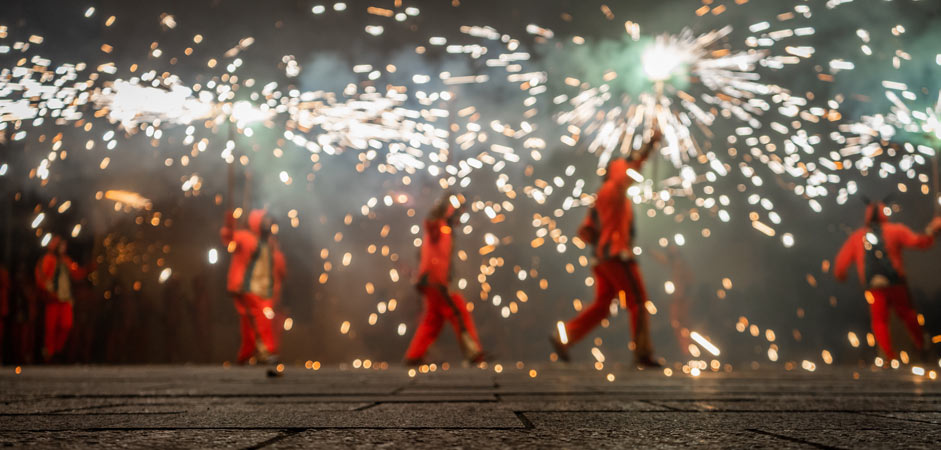
Day trips from Barcelona
When you’ve seen enough of the city of Barcelona, don’t hesitate to head outside the city to rural Catalonia. Go visit the natural wonders, such as the Montserrat limestone mountain, or enjoy the natural specialties, such as the products of Penedès wine region.
The train network around Barcelona is extensive with frequent connections, and as such train is a recommendable method of transport for day trips. By train, it’ll only take about an hour to get to one of the largest amusement parks in Europe, PortAventura.
Montserrat
Pick the Montserrat mountain and its monastery as one of the first locations to broaden your horizons in Catalonia. Montserrat, situated 50 kilometers away from Barcelona, is famous for its 1000-year-old monastery and the saw-toothed limestone formation around it.
There are several attractions on the mountain to visit in one day. There’s free access to the Santa Maria de Montserrat basilica. For a fee, you can visit the Montserrat Audiovisual Room introducing the life of Benedictine monks, or the Museum of Montserrat with art pieces from famous artists, such as Picasso, Dali or Chagall, to admire.
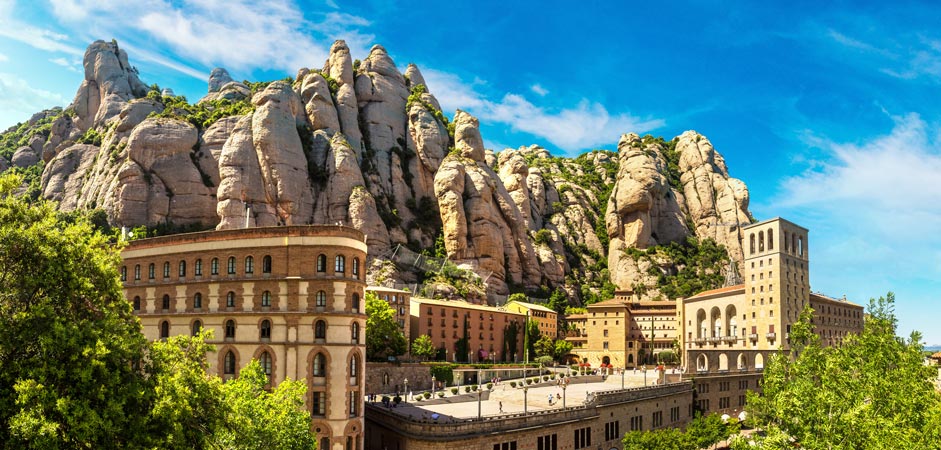
How to get there:
There are many different ways to get to the top of Montserrat; via a road, on foot, or using a rack railway or a cable car.
The rack railway or cogwheel train is called cremallera in Spanish, while the cable car is called aeri in Spanish.
If you are traveling by public transportation, you must first take the R5 line commuter train from Barcelona's Plaça Espanya and get off either at Monistrol de Montserrat station or Montserrat-Aeri station. The rack railway departs from Monistrol de Montserrat station, and the cable car from Montserrat-Aeri station. Montserrat-Aeri is located one station before Monistrol de Montserrat.
A round-trip ticket (includes: Plaça Espanya - Montserrat commuter train + cable car or rack railway to the mountain) costs around €26, and a one-way ticket €15. The ticket can only be purchased from machines or service points at Plaça Espanya station. Tickets sold online do not include the commuter train to Montserrat, except for the more expensive Trans Montserrat and Tot Montserrat tickets, which can be purchased from the rack railway company's website. These tickets also include other services, which you can read about on their website. If you buy a round-trip ticket, you must use either the cable car or the rack railway. By purchasing separate one-way tickets, you can, for example, take the commuter train + cable car up and the rack railway + commuter train down.
The commuter train from Plaça Espanya to Montserrat takes about an hour, with the cable car ride up the mountain taking only 5 minutes and the rack railway 15 minutes. The advantage of the cable car is the better views, but the journey is made standing. In the train, visibility is slightly worse, but there are seats and more space.
Rack Railway Website
Cable Car Website
Montserrat website
Vilafranca del Penedès
A day trip to the wine capital of Catalonia, Vilafranca del Penedèsiin, suits everyone from rookie wine enthusiasts to connoisseurs. As the train passes through the urban landscape of Barcelona towards the lush valleys, the buzz of the big city turns into the peace of the countryside.
The distance from Barcelona to Vilafranca del Penedès is 50 kilometers. The area surrounding Vilafranca del Penedès is better known as Penedès, while the village itself is called Vilafranca. Penedès’ wines and Cavas are famous around the world. Torres, the best-known wine family of the area, established their winery in Vilafranca in 1870.
Visit wineries, such as Mascaro or Pinord, at the very center of the wine village, or rent a bicycle and head to Pacs del Penedès three kilometers away, where also the Torres winery is located.
How to get there:
The local train R4 travels from the center of Barcelona to the Vilafranca del Penedès station. Hop on the train from, for instance, the stations of Catalonia Square or Sants. Local train R4 schedules
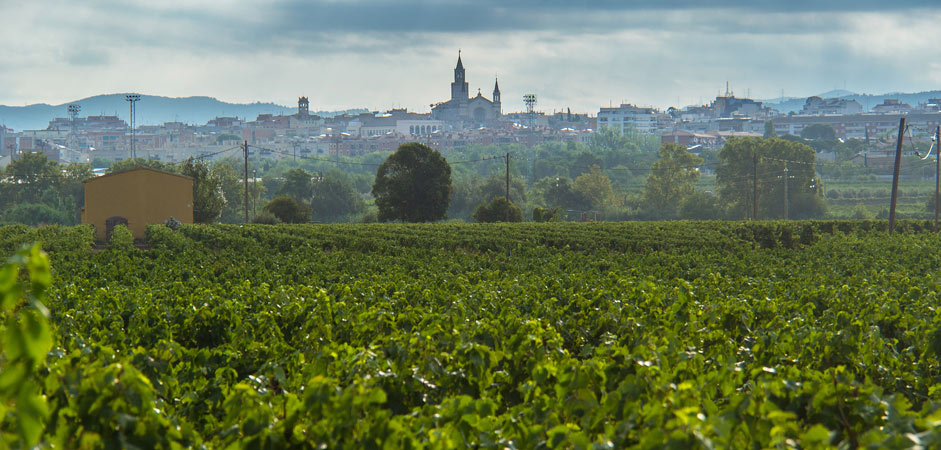
Sant Sadurni d’Anoia
Just as Penedès is the wine capital of Catalonia, Sant Sadurni d’Anoia is the Cava capital. The village is situated along the same R4 local train connection as Penedès, a couple of stops closer to Barcelona. In fact, it’s easy to combine the Cava and wine themes within a single day trip to Penedès.
The winery of perhaps the most famous Cava producer of the world, Freixenet, is situated next to the Sant Sadurni d’Anoia train station. Other famous Cava producers in the Village are Codorniu and Juvé & Camps.
Other day trip ideas:
· Sitges – a bohemian beach town near Barcelona
· PortAventura – a gigantic water and amusement park
Price level
Prices of restaurant services in the city are close to the average in the European Union, whereas the hotel prices are somewhat higher. Below, there are some examples of restaurant prices in Barcelona.
Pizza in restaurant
33 cl beer in restaurant
€12-15
€3-3.50
From the airport to Barcelona
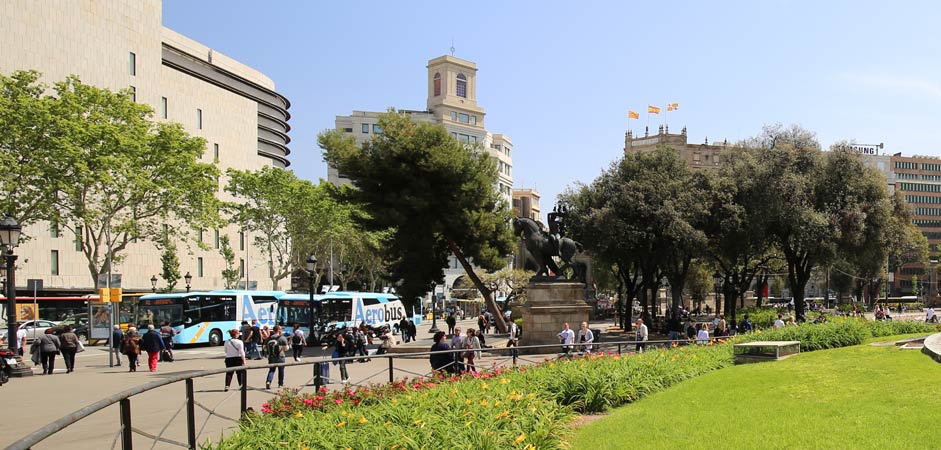
- Airport bus, Aerobús,is the easiest way to get to the city center. The last stop is at the Catalonia Square, in front of the department store El Corte Inglés. It’s the official shuttle bus between the airport El Prat and the Catalonia Square. Different bus lines operate between different airport terminals, so choose either A1 or A2, depending on whether you go to terminal 1 or 2. The destination terminal is indicated in front of the bus (A1 for T1 and A2 for T2).
The ride takes about 35 minutes and buses run frequently, every 5 or 10 minutes. Hence, there’s never a long waiting time.
There are three other stops between the airport and the Catalonia Square, and two when going the opposite direction. The stops, tickets and more information can be found here. There is a luggage rack inside the bus. Local traffic cards are not valid in Aerobús.
- Local bus: A cheaper option than Aerobús, is the bus line number 46, that goes from terminal 1 and 2 to Plaça Espanya. There aren't any luggage racks available like in Aerobús. Therefore, if you travel with plenty of luggage, a local bus might be uncomfortable.
- Trains operate from Terminal 2 only. Check schedules at Rodalies. The train ride takes 20 minutes to the main station Sants, and 27 minutes to the city center (station: Passeig de Gracía). You can buy e.g. a T10 Travel Card at the airport ticket machine; use one trip for this, and you have nine left. T10 card for Zone 1 costs 10.20 euros (it covers the whole city center). Zone 2+ is needed for neighboring towns. Metro Map.
- Metro is also an option. It's more expensive than a normal metro ride, since a special Airport metro ticket is needed. The line L9 doesn't go to the city center, but you can change to other lines closer to the city. There are metro stations in both terminals.
- Taxi: A taxi from Barcelona Airport to the city center, Plaça de Catalunya, costs on average around €40-45. You can also use Uber to get to and from Barcelona Airport to the city center, and the price might be slightly cheaper.
Weather in Barcelona
Winter: The winter months from December to February are often rainy, and average daily high temperatures vary between 5-15°C.
Spring: From March to May, it stops raining and the sun is out often. In March, daily highs climb to 15-20°C, and in May, they hit 20°C.
Summer: From June to August, sunshine is pretty much guaranteed, and daily highs exceed 30°C.
Autumn: September is still a warm month and it’s often beach weather throughout the month. In September, the daily highs stay well above 20 °C. In mid-October, the weather cools down to below 20°C and it starts to rain more often. In November, average daily highs drop to around 10°C.
Photos: Jussi Ryynänen, Adobe Stock
Video: Jussi Ryynänen
Music of the video: Summer Nights / The 126ers – Audio Library, Youtube